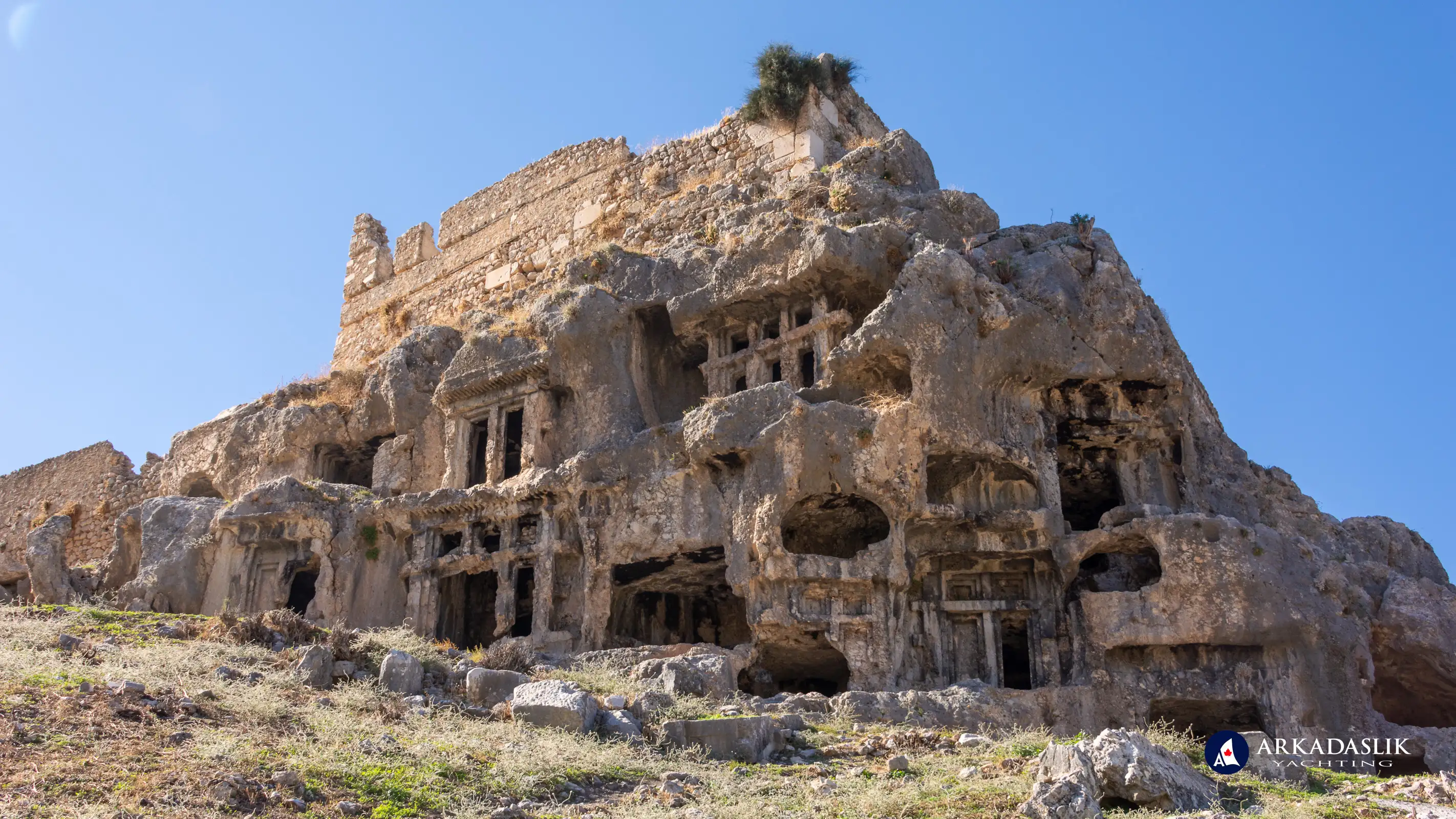Located at the foot of the Taurus Mountains, the ancient city of Tlos offers more than just ruins — it's a window into a past where myth and history intertwine. Wander through its remains and imagine the bustling life of a city that once stood at the crossroads of ancient cultures.
While Tlos' recorded history dates primarily to Lycian times (500 to 300 BC), archaeological finds like pottery shards and stone tools suggest human settlement as early as the Bronze Age (3300 to 1200 BC). The city was continuously inhabited until the 19th century, marking nearly 5000 years of history. Many artifacts from these periods are housed in the Fethiye Museum, offering a deeper understanding of Tlos' cultural heritage.
The Tlos Ruins
Tlos was one of the oldest and largest Lycian settlements, retaining significance even after the region became a Roman state (43 AD). It was added to the UNESCO World Heritage Temporary list in 2019, reflecting the city's importance in Lycian culture.
Dominated by an imposing acropolis, the site includes structures from various periods of the city’s long history.
- Acropolis
- Ottoman Castle: Built in the 14th century by Kanlı Ali Ağa ("Bloody Chief Ali") over older foundations. It was likely built atop previous structures, though details are scarce.
- Ottoman Stable: Constructed by Ali for his horse breeding operation, located below the castle.
- Necropolis: Numerous Lycian rock tombs carved into the acropolis' rocky base, with a few Roman and Lycian sarcophagi scattered around.
- Stadium: Once a center for sporting events, the stadium still boasts carved seating, though much of the structure is reclaimed by nature.
- Public Baths: Two bathhouses, including a Grand Bath with seven arched windows overlooking the Xanthos valley, showcasing Roman influence on Lycian culture.
- Palaestra (Sports School): A training facility for athletics.
- Gymnasium: A Roman structure for education and social interaction.
- Agora: The city’s commercial, political, and administrative center, now largely in ruins, lies between the church and basilica.
- Basilica: A large, cross-shaped building, possibly used for religious or civic functions.
- Theatre: The Roman-style theatre, once seating 5600 spectators, is partially damaged but still displays impressive relief carvings.
- Temple (Kronus Temple): A Corinthian-style temple honoring Kronus, the Greek god of time, built in the 2nd century BC.
The Pegasus Myth: Tlos’ Legendary Connection
The Bellerophon Tomb is one of Tlos' most iconic features. It celebrates the Greek myth of Bellerophon and Pegasus, where Bellerophon, aided by the gods, tamed Pegasus to defeat the Chimera. This myth of heroism and divine favor was central to Lycian culture.
Because of its location near the base of the necropolis, the tomb is difficult to access. However, it can be seen through the trees from the main road.
Visiting Tlos
Tlos is open to visitors year-round. Although it rarely gets "busy", it is definitely more popular during peak tourist season. During the summer, many tour operators offer a visit to Tlos as part of a day trip from Fethiye, which also includes stops at Yakapark and Saklikent Gorge.
Entrance Fees
The Tlos archaeological park is part of the extensive network of museums managed by the Turkish government. The entrance fee is 3 Euro (2024 price, payable only in Turkish Lira at the prevailing rate on your day of visit). Ensure you carry cash, as credit and debit card payments are not accepted. Visitors with a Muze Kart can enter the site for free.
Getting To Tlos
Tlos is located about 35 km from Fethiye. There is limited formal parking near the site, and most visitors park along the side of the secondary road passing through the ruins.
Accessibility
While the majority of Tlos is on a flat plain, the acropolis climb requires caution due to slippery, weathered stairs and a lack of handrails. Sturdy shoes are recommended, and the view from the top is worth the effort.
Explore the Ancient Ruins of Tlos Through Our Photo Gallery
Step back in time and explore the fascinating history of Tlos through our ever-expanding photo gallery. Discover the grandeur of the ruins, the breathtaking views, and the rich legacy of this ancient Lycian city.
Click on any image to expand.



























If you’re looking for an unforgettable day-trip from Fethiye, visit Tlos. Explore the open-air museum, immerse yourself in Lycian history, and enjoy the scenic beauty of this ancient city.
References Accessed for this Article
- A. N. Dinçer and I. Malkoç - Guide for Travellers: Tlos Ancient City and Environment, 1st edition, 2012.
- Taner Korkut - Tlos: A Lycian City on the Slopes of the Akdağ Mountains, 1st edition, 2016.
- Wikipedia – Tlos.
- Erdal Yazıcı - On the Lycian Way, 1st edition, 2012.



























